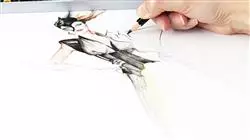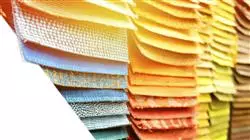University certificate
The world's largest faculty of engineering”
Introduction to the Program
This will enable students to learn the latest techniques for the elaboration of patterns on mannequins that allow them to create first class textile designs”

The fashion industry has reached an important relevance nowadays, due to the increase of interest in aesthetics and personal appearance. As a result, Textile Product Design has acquired a wide magnitude, as it is the discipline focused on the choice of materials and structures that will determine the comfort and durability of the garments. For this reason, specializing in this branch of Textile Engineering is a safe bet for those professionals who wish to be part of a sector that is in constant growth.
Faced with this situation, TECH has promoted the creation of this degree, with which the engineer will acquire the most relevant and advanced knowledge regarding Textile Product Design, especially focused on the field of fashion. Throughout the main parameters to design nonwoven fabrics and identify the most sophisticated materials to create different types of textile products based on the characteristics of a specific collection. Likewise, the student will delve into the handling of transformation and industrialization techniques of men's patterns for the creation of different types of garments.
Thanks to a 100% online modality through which this program is developed, the student will be able to achieve an excellent learning experience without the need of having to travel to a study center. In addition, this program is taught by specialists who are actively practicing in the field of Textile Product Design. Therefore, all the knowledge that the engineer will assimilate will be fully up-to-date and applicable in their professional life.
Through the didactic contents available in a wide range of textual and multimedia materials, you will acquire an excellent learning experience adapted to your study preferences”
This Postgraduate diploma in Textile Product Design contains the most complete and up-to-date program on the market. The most important features include:
- Case studies presented by experts in Textile Engineering and Textile Finishes
- The graphic, schematic, and practical contents with which they are created, provide practical information on the disciplines that are essential for professional practice
- Practical exercises where the self-assessment process can be carried out to improve learning
- Its special emphasis on innovative methodologies
- Theoretical lessons, questions to the expert, debate forums on controversial topics, and individual reflection assignments
- Content that is accessible from any fixed or portable device with an Internet connection
Learn, with this degree, to identify which are the most appropriate and sophisticated materials to design a textile product based on the characteristics of the collection to which it belongs”
The program’s teaching staff includes professionals from sector who contribute their work experience to this educational program, as well as renowned specialists from leading societies and prestigious universities.
Its multimedia content, developed with the latest educational technology, will provide the professional with situated and contextual learning, i.e., a simulated environment that will provide an immersive education programmed to learn in real situations.
The design of this program focuses on Problem-Based Learning, by means of which the professional must try to solve the different professional practice situations that are presented throughout the academic course. For this purpose, the student will be assisted by an innovative interactive video system created by renowned experts.
Through this degree, you will detect the techniques of transformation and industrialization of male patterns used to create different types of garments"

The advanced Relearning system of this degree will enable you to learn at your own pace from anywhere"
Why study at TECH?
TECH is the world’s largest online university. With an impressive catalog of more than 14,000 university programs available in 11 languages, it is positioned as a leader in employability, with a 99% job placement rate. In addition, it relies on an enormous faculty of more than 6,000 professors of the highest international renown.

Study at the world's largest online university and guarantee your professional success. The future starts at TECH”
The world’s best online university according to FORBES
The prestigious Forbes magazine, specialized in business and finance, has highlighted TECH as “the world's best online university” This is what they have recently stated in an article in their digital edition in which they echo the success story of this institution, “thanks to the academic offer it provides, the selection of its teaching staff, and an innovative learning method aimed at educating the professionals of the future”
A revolutionary study method, a cutting-edge faculty and a practical focus: the key to TECH's success.
The most complete study plans on the university scene
TECH offers the most complete study plans on the university scene, with syllabuses that cover fundamental concepts and, at the same time, the main scientific advances in their specific scientific areas. In addition, these programs are continuously being updated to guarantee students the academic vanguard and the most in-demand professional skills. In this way, the university's qualifications provide its graduates with a significant advantage to propel their careers to success.
TECH offers the most comprehensive and intensive study plans on the current university scene.
A world-class teaching staff
TECH's teaching staff is made up of more than 6,000 professors with the highest international recognition. Professors, researchers and top executives of multinational companies, including Isaiah Covington, performance coach of the Boston Celtics; Magda Romanska, principal investigator at Harvard MetaLAB; Ignacio Wistumba, chairman of the department of translational molecular pathology at MD Anderson Cancer Center; and D.W. Pine, creative director of TIME magazine, among others.
Internationally renowned experts, specialized in different branches of Health, Technology, Communication and Business, form part of the TECH faculty.
A unique learning method
TECH is the first university to use Relearning in all its programs. It is the best online learning methodology, accredited with international teaching quality certifications, provided by prestigious educational agencies. In addition, this disruptive educational model is complemented with the “Case Method”, thereby setting up a unique online teaching strategy. Innovative teaching resources are also implemented, including detailed videos, infographics and interactive summaries.
TECH combines Relearning and the Case Method in all its university programs to guarantee excellent theoretical and practical learning, studying whenever and wherever you want.
The world's largest online university
TECH is the world’s largest online university. We are the largest educational institution, with the best and widest online educational catalog, one hundred percent online and covering the vast majority of areas of knowledge. We offer a large selection of our own degrees and accredited online undergraduate and postgraduate degrees. In total, more than 14,000 university degrees, in eleven different languages, make us the largest educational largest in the world.
TECH has the world's most extensive catalog of academic and official programs, available in more than 11 languages.
Google Premier Partner
The American technology giant has awarded TECH the Google Google Premier Partner badge. This award, which is only available to 3% of the world's companies, highlights the efficient, flexible and tailored experience that this university provides to students. The recognition as a Google Premier Partner not only accredits the maximum rigor, performance and investment in TECH's digital infrastructures, but also places this university as one of the world's leading technology companies.
Google has positioned TECH in the top 3% of the world's most important technology companies by awarding it its Google Premier Partner badge.
The official online university of the NBA
TECH is the official online university of the NBA. Thanks to our agreement with the biggest league in basketball, we offer our students exclusive university programs, as well as a wide variety of educational resources focused on the business of the league and other areas of the sports industry. Each program is made up of a uniquely designed syllabus and features exceptional guest hosts: professionals with a distinguished sports background who will offer their expertise on the most relevant topics.
TECH has been selected by the NBA, the world's top basketball league, as its official online university.
The top-rated university by its students
Students have positioned TECH as the world's top-rated university on the main review websites, with a highest rating of 4.9 out of 5, obtained from more than 1,000 reviews. These results consolidate TECH as the benchmark university institution at an international level, reflecting the excellence and positive impact of its educational model.” reflecting the excellence and positive impact of its educational model.”
TECH is the world’s top-rated university by its students.
Leaders in employability
TECH has managed to become the leading university in employability. 99% of its students obtain jobs in the academic field they have studied, within one year of completing any of the university's programs. A similar number achieve immediate career enhancement. All this thanks to a study methodology that bases its effectiveness on the acquisition of practical skills, which are absolutely necessary for professional development.
99% of TECH graduates find a job within a year of completing their studies.
Postgraduate Diploma in Textile Product Design
The design of textile products is an area in constant evolution, thanks to the emergence of new techniques, materials and tools. To be at the forefront of this industry, TECH Global University offers the Postgraduate Diploma in Textile Product Design, a program that aims to train professionals capable of developing innovative and high quality textile products.
The most updated program in the industry.
The most updated program in Textile Design
The Postgraduate Diploma in Textile Product Design is a comprehensive program that addresses the main areas of textile product design, from research and trend analysis to the design and production of garments and fashion accessories. During the program, participants will acquire knowledge in areas such as color theory, project management, pattern making and textile technology, among others.
In addition, the program has a practical methodology that allows participants to put into practice the knowledge acquired through real projects, allowing them to develop skills and competencies that will be useful in their professional career.
A teaching team of excellence
The program has a teaching team of excellence, composed of professionals with extensive experience in textile product design and university teaching. These faculty members are committed to training participants and provide them with personalized accompaniment and constant feedback to ensure that they can achieve their goals and develop their full potential.







